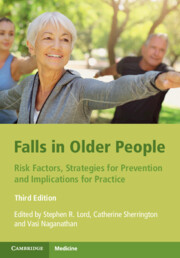Book contents
- Falls in Older People
- Falls in Older People
- Copyright page
- Contents
- Preface
- Contributors
- Part I Epidemiology and Risk Factors for Falls
- 1 Epidemiology of Falls and Fall-Related Injuries
- 2 Postural Stability and Falls
- 3 Gait Characteristics and Falls
- 4 Sensory and Neuromuscular Risk Factors for Falls
- 5 Biomechanics of Balance and Falling
- 6 Foot Problems, Footwear, and Falls
- 7 Brain Function and Falls
- 8 Impaired Cognition and Falls
- 9 The Psychology of Fall Risk: Fear, Anxiety, Depression, and Balance Confidence
- 10 Medical Risk Factors for Falls
- 11 Medications as Risk Factors for Falls
- 12 Environmental Risk Factors for Falls
- 13 Fall Detection and Risk Assessment with New Technologies
- 14 Fall Risk Screening and Assessment
- 15 The Relative Importance of Fall Risk Factors: Analysis and Summary
- Part II Strategies for Prevention
- Part III Implications for Practice
- Index
- References
14 - Fall Risk Screening and Assessment
from Part I - Epidemiology and Risk Factors for Falls
Published online by Cambridge University Press: 04 November 2021
- Falls in Older People
- Falls in Older People
- Copyright page
- Contents
- Preface
- Contributors
- Part I Epidemiology and Risk Factors for Falls
- 1 Epidemiology of Falls and Fall-Related Injuries
- 2 Postural Stability and Falls
- 3 Gait Characteristics and Falls
- 4 Sensory and Neuromuscular Risk Factors for Falls
- 5 Biomechanics of Balance and Falling
- 6 Foot Problems, Footwear, and Falls
- 7 Brain Function and Falls
- 8 Impaired Cognition and Falls
- 9 The Psychology of Fall Risk: Fear, Anxiety, Depression, and Balance Confidence
- 10 Medical Risk Factors for Falls
- 11 Medications as Risk Factors for Falls
- 12 Environmental Risk Factors for Falls
- 13 Fall Detection and Risk Assessment with New Technologies
- 14 Fall Risk Screening and Assessment
- 15 The Relative Importance of Fall Risk Factors: Analysis and Summary
- Part II Strategies for Prevention
- Part III Implications for Practice
- Index
- References
Summary
As outlined in previous chapters, falls are not random events and are associated with multiple risk factors. Fall risk increases in line with the cumulative effect of impairments, making a multi-factorial risk assessment important. A risk assessment should include tests with proven validity and reliability in the relevant setting and population, and linked to appropriate, evidence-based interventions to reduce fall risk. This chapter discusses the relevance and role of fall risk screening and assessment and provides information about validated tools that can be used to measure fall risk in the community, hospitals, and residential aged care.
- Type
- Chapter
- Information
- Falls in Older PeopleRisk Factors, Strategies for Prevention and Implications for Practice, pp. 227 - 236Publisher: Cambridge University PressPrint publication year: 2021



